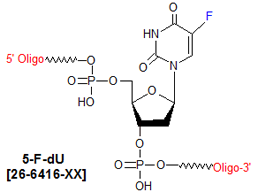
Modification : 5-F dU
Catalog Reference Number
Category
Modification Code
5 Prime
3 Prime
Internal
Molecular Weight (mw)
Extinction Coeficient (ec)
Technical Info (pdf)
Absorbance MAX
Emission MAX
Absorbance EC
26-6416
Duplex Stability
[5-F-dU]
Y
Y
Y
308.16
8.4
PS26-6416.pdf
-
-
-
| Catalog No | Scale | Price |
| 26-6416-05 | 50 nmol | $246.00 |
| 26-6416-02 | 200 nmol | $246.00 |
| 26-6416-01 | 1 umol | $310.00 |
| 26-6416-03 | 2 umol | $410.00 |
| 26-6416-06 | 5 umol | $909.00 |
| 26-6416-10 | 10 umol | $1,236.00 |
| 26-6416-15 | 15 umol | $1,760.00 |
| Discounts are available for 5-F dU! |
| Modification* Discount Price Structure |
|
1 site/order
|
List price
|
|
2 sites/order
|
10% discount
|
|
3 sites/order
|
20% discount
|
|
4 sites/order
|
30% discount
|
|
5-9 sites/order
|
50% discount
|
|
10+ sites/order
|
60% discount
|
|
*Exceptions apply
|
5-Fluoro deoxyuridine (5-F-dU) is classified as a halogenated nucleotide. 5-F-dU is able to pair with both A and G purines, and A:(5-F-dU)and G:(5-F-dU) base pairs are more stable than A:T and G:T (mismatch) base pairs, respectively. This property has been used to synthesize single, unique hybridization probes for use in cDNA library screening. Such individual probes are more selective for particular gene sequences, particularly low abundance sequences, than sets of mixed hybridization probes, which use often leads to spurious hybridization (1).
5-F-dU can be incorporated into oligos as labels to enable probing of DNA/RNA secondary structure by 19F NMR (2). Oligos in which 5-F-dU was substituted for T have also been used to probe the structure of T-CG inversions in anti-parallel triple helices (3). In that study, 5-F-dU was found to have higher binding affinity for the CG base pair than thymine, and much higher affinity than other halogenated derivatives. Thus, 5-F-dU may have the potential to enhance the ability of a triple-helix forming oligo (TFO) to recognize this motif within a target DNA or RNA molecule (4).
Because the dipole moment of the C-F bond in 5-F-dU is similar to that of the C-Br bond in both 5-Br-dU and 5-Br-dC, 5-F-dU can function as a non-photoreactive “polarity placeholder” during conversion of a SELEX-identified aptamer into a photo-aptamer (5). For example, aptamers selected from a candidate nucleic acid mixture containing 5-F-dU instead of thymine could subsequently be optimized post-SELEX by replacing 5-F-dU with either 5-Br-dU or 5-Br-dC, both of which are highly photo-reactive. The similarity in the relevant dipole moments of these halogenated nucleotides helps ensure that the binding affinity of the post-SELEX-optimized photo-aptamer for its target is the same, or nearly the same, as that of the original aptamer.
References
1. Habener, J.F.; Vo, C.D.; Le, D.B.; Gryan, G.P.; Ercolani, L.; Wang, A.H-J.. 5-Fluorodeoxyuridine as an alternative to the synthesis of mixed hybridization probes for the detection of specific gene sequences.
Proc. Natl. Acad. Sci. USA (1988),
85: 1735-1739.
2. Puffer, B.; Kreutz, C.; Rieder, U.; Ebert, M-O.; Konrat, R.; Micura, R. 5-Fluoro pyrimidines: labels to probe DNA and RNA secondary structures by 1D 19F NMR Spectroscopy.
Nucleic Acids Res. (2009),
37: 7728-7740.
3. Durland, R.H.; Rao, T.S.; Revankar, G.R.; Tinsley, J.H.; Myrick, M.A.; Seth, D.M.; Rayford, J.; Singh, P.; Jayaraman, K. Binding of T and T analogs to CG pairs in antiparallel triplexes.
Nucleic Acids Res. (1994),
22: 3233-3240.
4. Gowers, D.M.; Fox, K.R. Towards mixed sequence recognition by triple-helix formation.
Nucleic Acids Res. (1999),
27: 1569-1577.
5. Schneider, D.J.; Wilcox, S.K.; Zichi, D.; Nieuwlandt, D.; Carter, J.; Gold, L. Improved SELEX and Photo-SELEX. (2008), PCT/US2008/070371 (WO/2009/012410).
- 5-Fluoro deoxyuridine dU
